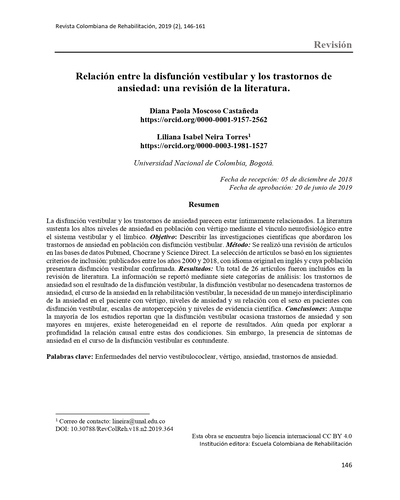Relación entre la disfunción vestibular y los trastornos de ansiedad: una revisión de la literatura
Contenido principal del artículo
Autores
Diana Paola Moscoso Castañedadpmoscosoc@unal.edu.co
Liliana Isabel Neira Torres
lineira@unal.edu.co
Resumen
La disfunción vestibular y los trastornos de ansiedad parecen estar íntimamente relacionados. La literatura sustenta los altos niveles de ansiedad en población con vértigo mediante el vínculo neurofisiológico entre el sistema vestibular y el límbico. Objetivo: Describir las investigaciones científicas que abordaron los trastornos de ansiedad en población con disfunción vestibular. Método: Se realizó una revisión de artículos en las bases de datos Pubmed, Chocrane y Science Direct. La selección de artículos se basó en los siguientes criterios de inclusión: publicados entre los años 2000 y 2018, con idioma original en inglés y cuya población presentara disfunción vestibular confirmada. Resultados: Un total de 26 artículos fueron incluidos en la revisión de literatura. La información se reportó mediante siete categorías de análisis: los trastornos de ansiedad son el resultado de la disfunción vestibular, la disfunción vestibular no desencadena trastornos de ansiedad, el curso de la ansiedad en la rehabilitación vestibular, la necesidad de un manejo interdisciplinario de la ansiedad en el paciente con vértigo, niveles de ansiedad y su relación con el sexo en pacientes con disfunción vestibular, escalas de autopercepción y niveles de evidencia científica. Conclusiones: Aunque la mayoría de los estudios reportan que la disfunción vestibular ocasiona trastornos de ansiedad y son mayores en mujeres, existe heterogeneidad en el reporte de resultados. Aún queda por explorar a profundidad la relación causal entre estas dos condiciones. Sin embargo, la presencia de síntomas de ansiedad en el curso de la disfunción vestibular es contundente.
Palabras clave:
Detalles del artículo
Licencia
Aquellos autores/as que tengan publicaciones con esta revista, aceptan los términos siguientes:
- Los autores/as conservarán sus derechos de autor y garantizarán a la revista el derecho de primera publicación de su obra, el cuál estará simultáneamente sujeto a la Licencia de reconocimiento de Creative Commons que permite a terceros compartir la obra siempre que se indique su autor y su primera publicación esta revista.
- Los autores/as podrán adoptar otros acuerdos de licencia no exclusiva de distribución de la versión de la obra publicada (p. ej.: depositarla en un archivo telemático institucional o publicarla en un volumen monográfico) siempre que se indique la publicación inicial en esta revista.
- Se permite y recomienda a los autores/as difundir su obra a través de Internet (p. ej.: en archivos telemáticos institucionales o en su página web) antes y durante el proceso de envío, lo cual puede producir intercambios interesantes y aumentar las citas de la obra publicada. (Véase El efecto del acceso abierto).
Los autores que publican en la revista se acogen al código de licencia de Creative Commons Atribución 4.0 Internacional (CC BY 4.0)




Referencias
Bartual, J., Pérez, N. (1999). El sistema vestibular y sus alteraciones: Patología (Vol. II). Masson SA. Barcelona, España.
Barton, S., Karner, C., Salih, F., Baldwin, D. S., & Edwards, S. J. (2014). Clinical effectiveness of interventions for treatment-resistant anxiety in older people: A systematic review. Health Technology Assessment, 18(50), 1–62. Doi: 10.3310/hta18500
Best, C., Eckhardt-Henn, A., Diener, G., Bense, S., Breuer, P., & Dieterich, M. (2006). Interaction of somatoform and vestibular disorders. J Neurol Neurosurg Psychiatry, 77(5), 658–664.
Carvajal, A., Flores, M., Marin, S. I., & Morales, C. G. (2016). Anxiety disorders during menopausal transition. Perinatología y Reproducción Humana, 30(1), 39–45. Doi: 10.1016/j.rprh.2016.03.003
Comorbidity, P., Paroxysmal, B., Ferrari, S., Monzani, D., Baraldi, S., Simoni, E., & Pingani, L. (2014). Vertigo “In the pink ”: The impact of female gender on positional vertigo patients. Psychosomatics, 55(3), 280–288. Doi: 10.1016/j.psym.2013.02.005
Eckhardt-Henn, A., Breuer, P., Thomalske, C., Hoffmann, S. O., & Hopf, H. C. (2003). Anxiety disorders and other psychiatric subgroups in patients complaining of dizziness. Journal of Anxiety Disorders, 17(4), 369–388. Doi: 10.1016/s0887-6185(02)00226-8
Esearch, R., Godemann, F., Neu, P., Seidl, R., & Stro, A. (2005). What accounts for vertigo one year after neuritis vestibularis – anxiety or a dysfunctional vestibular organ?, 39, 529–534. doi: 10.1016/j.jpsychires.2004.12.006
Godemann, F., Linden, M., Neu, P., Heipp, E., & Dörr, P. (2004). A prospective study on the course of anxiety after vestibular neuronitis. Journal of Psychosomatic Research, 56(3), 351–354. Doi: 10.1016/s0022-3999(03)00079-5
Goto, F., Nomura, K., Taka, F., Arai, M., & Sugaya, N. (2017). Analysis of factors affecting the outcomes of in-hospitalized vestibular rehabilitation in patients with intractable dizziness. Otology & Neurotology, 38(3), 368–372. Doi: 10.1097/mao.0000000000001297
Grace Gaerlan, M., Alpert, P. T., Cross, C., Louis, M., & Kowalski, S. (2012). Postural balance in young adults: The role of visual, vestibular and somatosensory systems. Journal of the American Academy of Nurse Practitioners, 24(6), 375–381. Doi: 10.1111/j.1745-7599.2012.00699.x
Gurvich, C., Maller, J. J., Lithgow, B., Haghgooie, S., & Kulkarni, J. (2013). Vestibular insights into cognition and psychiatry. Brain Research, 1537, 244–259. Doi: 10.1016/j.brainres.2013.08.058
Heinrichs, N., Edler, C., Eskens, S., Mielczarek, M., & Moschner, C. (2007). Predicting continued dizzness after an acute peripheral vestibular disorder. Psychosomatic Medicine, 69(7), 700-707. Doi: 10.1097/psy.0b013e318151a4dd
Jacob, R. G., Whitney, S. L., Detweiler-Shostak, G., & Furman, J. M. (2001). Vestibular rehabilitation for patients with agoraphobia and vestibular dysfunction: A pilot study. Journal of Anxiety Disorders, 15(1–2), 131–146. Doi: 10.1016/s0887-6185(00)00047-5
Kahraman, S. S., Arli, C., Copoglu, U. S., Hanifi, M., & Colak, S. (2016). The evaluation of anxiety and panic agarophobia scores in patients with benign paroxysmal positional vertigo on initial presentation and at the follow-up visit. Acta Oto-Laryngologica, 137(5), 485–489. Doi: 10.1080/00016489.2016.1247986
Kim, S. K., Kim, Y. B., Park, I., Hong, S. J., Kim, H., & Hong, S. M. (2016). Clinical analysis of dizzy patients with high levels of depression and anxiety. Journal of Audiology & Otology, 20(3), 174–178. Doi: 10.7874/jao.2016.20.3.174
Kirby, S. E., & Yardley, L. (2009). Cognitions associated with anxiety in Ménière’s disease. Journal of Psychosomatic Research, 66(2), 111–118. Doi: 10.1016/j.jpsychores.2008.05.027
Kozak, H. H., Dündar, M. A., Uca, A. U., Uğuz, F., Turgut, K., Altaş, M., & Azİz, S. K. (2018). Anxiety, mood and personality disorders in patients with Benign Paroxysmal Positional Vertigo. Archives of Neuropsychiatric, 55, 49–53. Doi: 10.5152/npa.2016.18143
Kurre, A., Straumann, D., van Gool, C. J., Gloor-Juzi, T., & Bastiaenen, C. H. (2012). Gender differences in patients with dizziness and unsteadiness regarding self-perceived disability, anxiety, depression, and its associations. BMC Ear, Nose and Throat Disorders, 12(1), 2. Doi: 10.1186/1472-6815-12-2
Kutay, O., Akdal, G., Pembe Keskinoglu, & Birgul Donmez Balc. (2017). Vestibular migraine patients are more anxious than migraine patients without vestibular symptoms. Journal of Neurology, 264(Suppl 1), 37–41. Doi: 10.1007/s00415-017-8439-6
Liu Mingyong, & Zhou Lichun. (2017). Prevalence of anxiety and depression before idiopathic benign paroxysmal positional vertigo episode. Chinese Journal of Neurology, 50(5), 358–361.
Meli, A., Zimatore, G., Badaracco, C., De Angelis, E., & Tufarelli, D. (2007). Effects of vestibular rehabilitation therapy on emotional aspects in chronic vestibular patients. Journal of Psychosomatic Research, 63(2), 185–190. Doi: 10.1016/j.jpsychores.2007.02.007
Miyazaki, H., Nomura, Y., Mardassi, A., Deveze, A., Jike, M., & Magnan, J. (2017). How minimally invasive vestibular neurotomy for incapacitating Meniere’s disease improves dizziness and anxiety. Acta Oto-Laryngologica, 137(7), 707–711. Doi: 10.1080/00016489.2017.1278790
Monzani, D., Casolari, L., Guidetti, G., & Rigatelli, M. (2001). Psychological distress and disability in patients with vertigo. Journal of Psychosomatic Research, 50(6), 319–323. Doi: 10.1016/s0022-3999(01)00208-2
Murillo, F., & Víquez, Z. (2001). Vértigo: Una visión otorrinolaringológica para la medicina general. Acta Médica Costarricense, 44(1), 10-18.
Piker, E. G., Jacobson, G. P., McCaslin, D. L., & Grantham, S. L. (2008). Psychological comorbidities and their relationship to self-reported handicap in samples of dizzy patients. Journal Of The American Academy Of Audiology, 19(4), 337–347. Doi: 10.3766/jaaa.19.4.6
Pollak, L., Klein, C., Rafael, S., Vera, K., & Rabey, J. M. (2003). Anxiety in the first attack of vertigo. Otolaryngology - Head and Neck Surgery, 128(6), 829–834. Doi: 10.1016/s0194-5998(03)00454-6
Rajagopalan, A., Jinu, K., Sailesh, K., Mishra, S., Reddy, U., & Mukkadan, J. (2017). Understanding the links between vestibular and limbic systems regulating emotions. Journal of Natural Science, Biology and Medicine, 8(1), 11–15. Doi: 10.4103/0976-9668.198350
Roh, K. J., Kim, M. K., Kim, J. H., & Son, E. J. (2018). Role of emotional distress in prolongation of dizziness : A cross-sectional study. Journal of Audiology and Otology, 22(1), 6–12. Doi: 10.7874/jao.2017.00290
Saman, Y., Mclellan, L., Mckenna, L., Dutia, M. B., Schubert, M., & Jahn, K. (2016). State anxiety subjective imbalance and handicap in vestibular Schwannoma. Frontiers in Neurology, 7(101), 1–8. Doi: 10.3389/fneur.2016.00101
Sousa, M., Navas, Z., Laborde, M., José, J., & Carrascosa, U. (2012). Levels of scientific evidence and degrees of recommendation. Revista de La Sociedad Andaluza de Traumatología y Ortopedia, 29(1), 59–72.
Teggi, R., Caldirola, D., Bondi, S., Perna, G., Bellodi, L., & Bussi, M. (2007). Vestibular testing in patients with panic disorder and chronic dizziness. Acta Otorhinolaryngologica Italica, 27(5), 243–247.
Wei, W., Zahra N. Sayyid, Ma, X., Wang, T., & Dong, Y. (2018). Presence of anxiety and depression symptoms affects the first time treatment efficacy and recurrence of Benign Paroxysmal Positional Vertigo. Frontiers in Neurology, 9(March), 1–8. Doi: 10.3389/fneur.2018.00178
Wiltink, J., Tschan, R., Michal, M., Subic-Wrana, C., Eckhardt-Henn, A., Dieterich, M., & Beutel, M. (2009). Dizziness: Anxiety, heatlh care utilization and health behavior- Results from a representative German community survet. Journal of Psychosomatic Research, 66, 417-424. Doi: 10.1016/j.jpsychores.2008.09.012
Yardley, L., & Kirby, S. (2006). Evaluation of Booklet-Based Self-Management of Symptoms in Ménière Disease: A Randomized Controlled Trial. Psychosomatic Medicine, 68(5), 762–769. Doi: 10.1097/01.psy.0000232269.17906.92
Yuan, Q., Yu, L., Shi, D., Ke, X., & Zhang, H. (2015). Anxiety and depression among patients with different types of vestibular peripheral vertigo. Medicine, 94(5), e453. Doi: 10.1097/md.0000000000000453
Zhai, F., Wang, I., Zhang, Y., & Dai, C. (2016). Quantitative analysis of psychiatric disorders in intractable peripheral vertiginous patients : A prospective study. Otology & Neurotology, 37, 539–544. Doi: 10.1097/mao.0000000000001002
Zur, O., Schoen, G., Dickstein, R., Feldman, J., Berner, Y., Dannenbaum, E., & Fung, J. (2015). Anxiety among individuals with visual vertigo and vestibulopathy. Disability & Rehabilitation, 37(23), 2197–2202. Doi: 10.3109/09638288.2014.1002577


 PDF
PDF










